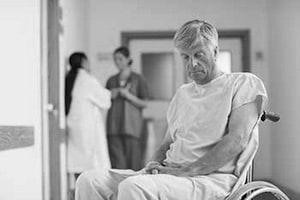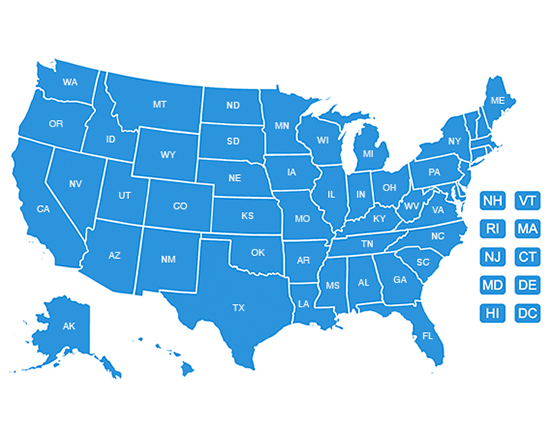The Nursing Home Law Center is committed to providing the legal resources necessary to hold negligent facilities accountable.
Nursing Home Wheelchair Accident Lawyers

Nursing homes provide elderly residents with 24/7 care services, daily living assistance, and comfortable accommodations. Facilities are designed to improve the quality of life for every resident, including meeting their healthcare needs and providing social opportunities.
Many residents in nursing facilities have mobility limitations and require a wheelchair to move around the property. Sadly, wheelchair accidents are common, especially if these devices are improperly used or there is inadequate supervision.
Nursing homes can be held liable for accidents, such as if a resident were to fall forward due to being left alone. The manufacturer can be held liable for falling if it is due to mechanical issues. A professional nursing home injury attorney can help you hold the liable parties accountable.
Wheelchair Use in Nursing Homes
A wheelchair is a common sight in nursing homes across the country. It allows residents to move around the facility independently, improving their self-determination. A wheelchair is also helpful for nursing home staff members who assist residents with their movements, such as taking them to a shower stall.
It can help a staff member transport a nursing home resident to their room, the bathroom, the cafeteria, common rooms, and transportation when off-site.
Types of Wheelchair-Related Accidents
Accidents are quite common in nursing home settings. When wheelchair accidents occur, residents can be easily injured. The damage they suffer in the accident may depend on how the incident occurs. Here are several concerns for wheelchair users in nursing homes.
Falls from Wheelchairs
One of the most common causes of wheelchair injuries is falling. Many of these falls occur when nursing home staff members transfer patients to or from the wheelchairs.
Falls can happen while the person is being transported, especially if they are on an uneven service or going too fast. Finally, if a staff member is not using the wheelchair safely and following proper protocols, they could endanger the resident’s health.
Tipping or Rolling Accidents
In most situations, a wheelchair is a safe place for a patient to sit. However, unstable wheelchairs, uneven surfaces, or improper maneuvering by nursing home staff can make the wheelchair tip or roll over.
A chair that tips or rolls over will throw the occupant to the ground, and when that occupant is an elderly resident in a nursing home, they could suffer severe injuries. Many residents suffer broken bones or a head injury and wind up in the hospital after a fall.
Collisions with Objects or Other People
Some wheelchair injuries happen because of collisions. An overcrowded room could easily be the site of a chair collision that injures patients. Cluttered hallways with medical equipment or debris can make a person in a wheelchair collide with an object and get injured.
Lastly, insufficient supervision could allow residents to endanger themselves by operating wheelchairs alone.
Entrapment or Injuries from Wheelchair Components
The components of a wheelchair may also be dangerous to a nursing home resident. For example, their fingers could get jammed in the brake system or the wheel’s spokes.
Faulty brakes, loose parts, or improper adjustments could lead to entrapment or injuries for the victim. Many nursing homes don’t provide wheelchairs but get them from a third party, so they don’t inspect the chair to ensure it works properly.
Causes of Wheelchair Accidents in Nursing Homes
Nursing home staff must safeguard all residents, especially when wheelchair use is involved. The potential for a lawsuit against the institution may depend on what caused the accident. Here are several common causes of accidents involving wheelchairs.
Negligence and Inadequate Care
Nursing home residents have the right to receive high-quality care from the staff and facility. Negligence and inadequate care could cause a wheelchair incident that severely injures a resident or causes broken bones.
Improper training may lead to a nurse not securing the wheelchair properly. Failing to assist with a transfer, such as from the chair to the bed, would likely cause a fall injury. Failing to supervise a resident at all times could allow them to endanger themselves. Some staff members may simply ignore the needs and limitations of certain residents who use wheelchairs.
Environmental Hazards
The nursing home environment can be hazardous. If there are uneven floors or ramps throughout the facility, the chances of a wheelchair injury will increase. Cluttered hallways create additional hazards for wheelchair users to navigate. If an area of the nursing home is poorly lit, a person in a wheelchair could fall forward if they hit an unseen obstacle.
A facility that lacks safety features like alert systems could be at fault for injuries suffered by a wheelchair user if they fall. Environmental factors could put residents at risk and often means the facility should be held liable when accidents occur.
Equipment Issues
The wheelchair itself could be a danger to the resident. For example, if defective brakes or wheels are defective, even correct wheelchair use could still cause harm. Missing or broken parts would compromise the wheelchair’s operation, increasing the risk of injury.
Even minor issues like a poorly adjusted footrest or armrest could increase the risk of injury. This is why wheelchair maintenance and proper use training are essential for nursing home employees.
Wheelchair Injuries in Nursing Homes
Many nursing home residents who use wheelchairs have suffered significant injuries. Fractures to the hips, legs, or arms are commonly associated with wheelchair falls. Head injuries, such as concussions, are possible if the resident’s head hits the floor or another object.
Muscle strains and ligament sprains may occur if the patient’s body is thrown from the seat. A collision involving a vulnerable resident could cause lacerations or bruises. In extreme cases, a wheelchair accident could result in spinal cord injuries.
The Impact on Residents
These injury concerns must be taken seriously, whether you or a loved one is living in the nursing home. A loved one’s injury could cause physical pain, reduced mobility, emotional distress, prolonged recovery, and even a decreased quality of life. The entire nursing home staff must understand the dangers of wheelchair use to prevent these consequences.
Legal Rights of Nursing Home Residents
Since each nursing home resident has the right to receive quality care and maintain a dignified existence, the facility and its staff can be held liable when they fail to meet that standard. If you or a loved one have suffered a wheelchair injury, you could pursue compensation for legal damages.
Nursing Home’s Duty of Care
The nursing home has a professional duty of care toward every resident. The staff is responsible for caring for patients and providing for their needs, including assistance with basic needs, medical services, and social interactions.
The nursing home must be a safe environment, and staff should focus on preventing foreseeable incidents such as wheelchair accidents or falls. For example, a loved one should not feel they must move themselves from the bed to the chair without assistance.
Proving Negligence
Proving negligence is the key to winning a nursing home abuse or neglect lawsuit. Proving duty of care is just one step of the process. You must also prove that the nursing home breached the duty of care, that there is a causal link between the defendant’s actions and the harm suffered, and that there are legal damages that resulted from the incident.
Seeking Compensation
If your claim is successful, you can earn compensation from the nursing home or its insurance company to cover legal damages. Legal damages in a wheelchair injury case may include medical bills, future medical expenses, pain and suffering, emotional distress, and loss of quality of life.
You could also receive punitive damages if your case involves gross negligence or intentional misconduct.
The Role of a Nursing Home Wheelchair Accident Lawyer
If you or a family member suffered abuse or neglect in a nursing home, your best chance of winning compensation is with the help of an experienced lawyer. Here are a few ways a nursing home attorney can help with your claim.
Investigating the Accident
The lawyer’s job is to investigate the incident and determine the truth. They will look into the circumstances of the accident, gather evidence, interview witnesses, and consult experts to build a case on your behalf.
Establishing Liability
The primary obstacle to winning a settlement is establishing liability. For the nursing home to be held liable for your damages, your lawyer must be able to prove negligence. This will require substantial evidence to prove that your suffering was more likely than not caused by the staff’s negligence.
Potential evidence may include medical records, images of pressure sores, imaging scans of injuries, eyewitness statements, and video footage of the incident.
Negotiating with Insurance Companies
The nursing home and insurance company will seek to settle the case, but the first offer is usually less than the victim deserves. Your lawyer will help you negotiate with a tough strategy to fight for maximum compensation so all your losses are covered.
Representing You in Court
Your case can advance to a civil court. In that scenario, your attorney will prepare you for the trial, represent your interests, and present your case before the judge and jury. Having a legal expert with you in court is essential since they understand the relevant laws regarding nursing home abuse and neglect.
Secure Expert Legal Representation!
At the Nursing Home Law Center, we strive to ensure residents and their families can hold these institutions accountable for causing preventable suffering. Our team is ready to protect your rights and build a solid case to increase your chances of earning every dollar you deserve.
Contact us today at 800-926-7565 or complete the online form to request your free consultation with an experienced nursing home abuse lawyer.


